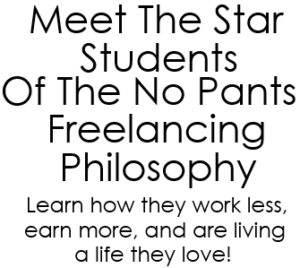Chances are good that as a freelancer, you struggle with saying, “No.”
Especially when you’re new to freelancing, or just starting to see some real success, the thought of turning down paid work and client opportunities can sound bananas.
But part of being a freelancer is running your business – it’s being CEO of your own individual company and ensuring that you’re steering your company toward the future and goals that you really want and that will serve you best.
In the recent podcast titled, “How To Know What You Want”, Mike Shreeve, founder and head troublemaker for The No Pants Project, says:
“It’s my opinion that the greatest power in forward momentum is the ability to simply say ‘No’.”
If you say yes to every opportunity that lands in your lap, regardless of whether or not it serves you, it’s likely that you’re going to end up somewhere completely different from where you wanted to go.
So to help you clarify the importance and purpose of “No,” as well as how to use it properly within the context of your business, we’ve gathered up and organized some sage advice from the experts into a step-by-step process you can fall back on.
Below are six key insights and strategies when it comes to why and how we need to be saying “No” in order to keep growing in our freelancing businesses.
1. Figure out and hone in on what you really want by saying NO.

There’s a reason why one of the first things we say as children is ‘No.’
It’s all about building an independent identity by defining boundaries.
We say, “No,” first to push those boundaries and see how far they can go, how that feels, and when it stops serving us.
By doing this, we discover what it is we really want.
And when we know what we want, it becomes that much easier to say no to something that doesn’t line up.
Carthage Buckley of Coaching Positive Performance, says:
“Many people think that setting goals is only about identifying things that you would like to do so you can spend more time doing them. But just as importantly, great goals tell you what you should not be doing. This allows you to say No to the things that are not of real value to you; thus, allowing you to spend more time on the things that help you live the life you really want to live. Saying No to the time wasters leaves you with time to say Yes to the real opportunities that come your way.”
And the same is true for your freelancing business.
Once you have a clear goal in mind, you’ll be able to spot opportunities and clients that don’t help you achieve that goal much more easily.
Then it comes down to exercising the muscle of saying no the right way.
2. Develop a go-to phrase for saying NO ahead of time and practice it until it is something clear, positive, and respectful.

Often times when we’re trying to say no in a non-confrontational way, we use unclear words like ‘maybe,’ ‘I’ll think about it,’ and so on.
But think about the way people are trained to think and behave by our society.
We’re taught to keep pushing, to keep overcoming obstacles and objections in order to succeed – just look at telemarketers to see this in action.
If we haven’t been diligent about setting boundaries, we’ve actually trained the people around us to continue this behavior because we’ve allowed it to work for them in the past.
That’s why experts recommend creating and honing a go-to phrase that works for you.
Christine Carter shares many phrases you can borrow for specific situations, but this one is great as a general starting point:
“Thank you for asking, but that isn’t going to work out for me.”
The key is to find a phrase that works for you, but is still full of gratitude, kindness and respect, and then use it any time you find yourself in a situation where you might have previously made excuses or come up with a story to help you soften the blow.
J.T. O’Donnell, Founder and CEO of WorkItDaily.com, writes:
“It’s how you explain what’s holding you back that will impact whether they’d ever consider you for a job in the future. Don’t assume you will never want to work there. The job market is a lot smaller than you think. Times change, and so do your needs.”
By doing it this way, you respect the request and the person making it, but you also respect your own boundaries, autonomy, and need to take the actions and projects that serve you best at this moment in time.
3. Set and maintain boundaries, but recognize that they will change and grow with you.

As you grow older, wiser, and more experienced within your business, things are going to change. Your goals will change, your hobbies will change, the things you enjoy might change.
That’s why while it’s important to set and maintain boundaries, it’s also important to change and update those boundaries as you grow and move on to new places in your life and business.
That’s part of why it is so important to say No in a way that is full of grace and gratitude and leaves the receiver with a positive feeling.
You will always reach a point where you need to make a decision and say no to something, but if you always do this with grace then you leave yourself the opportunity and space to make new choices in the future.
Jami Oetting writes for HubSpot:
“You never know who on the client side might move on to another brand and remember your agency in a positive light — or the client could even return to your agency after working with another firm.”
Pay attention to how a client, project, or business is making you feel and where they are taking you.
Let yourself grow by letting go and establishing new boundaries when the excitement, purpose, or joy is no longer there.
4. Never add to your to-do list, only exchange or replace.

In order to avoid over committing yourself, prioritize your tasks by what needs to be done versus what you want to get done.
Understand that if something new comes up, one of those things needs to come off the list – never adding, just exchanging.
Joshua Spodek, author of Leadership Step by Step, explains the dangers of trying to do too many things for Forbes:
“What does “too many things” mean? It means saying yes to mediocre or good things that crowd out great things. We all do it. Something seems great in the moment. We want it.
“We don’t think about the resources it will take. Then when we do it we realize we can’t do something else we wanted to.
“We make ourselves mediocre, ironically by chasing what we imagine is greatness.
“When I can magically create more time and other resources, I’ll say yes to more things. Until then, I’ve learned to decline good things to have a great life.”
We suggest that you keep it simple:
Pick 4 things that you really need to complete in order to move forward.
Then pick 4 (or less) things that you want to do, work-related or not, and fit these in around the tasks and duties of everyday life.
Anything else that may come up can only replace one of those 8 items, so you’ll need to be choosy about what you allow to take the place of your original priorities, using your “No Phrase” to protect your best interests.
“If you work in a job in which things really do come up and need to be dealt with ASAP, leave one or two of your slots open each day to fill in with the most important immediate needs.”
Bonus Listening: Mike explained on the podcast how to create your daily roadmap in the episode 2 Things You Can Do To 10x Productivity.
5. Find and limit your vices.
It’s also important to pay attention to what you’re seeking and what you’re avoiding when you prioritize tasks and people, put things off, or try to squeeze things in.
Rocky Russo, Founder of Elevated Being, writes:
“Think: get to know yourself on a very personal level. Do not be afraid or ashamed to set an appointment with yourself to ask the more serious questions in which only You know the answers. When you become aware of your vices you can begin to control them. Set your boundaries and have plans in place.”
If your vices don’t serve you or move you forward, they keep you stuck or even drag you back from the big things you are doing.
So saying no to personal vices will give you more space and energy for your real priorities.
6. Be intentional about what you say “Yes” to.

One important way to help make saying “No” easier for you is to approach it from the opposite side.
Ask yourself how many “Yeses” you can afford.
This comes back to understanding that we all have hard limits on our time and energy, so we need to keep that in the forefront of our mind when approaching what we say yes to.
For example, how many yeses can you afford in your business before you’re withdrawing from the banks of your friends and family yeses?
How many yeses can you afford before you’re sacrificing your own well-being, the well-being of your relationships, or the well-being of the quality of your work and your enjoyment of it?
How many yeses can you afford before they stop becoming an investment and start becoming a liability, both financially and personally?
Keep in mind that the yeses you can afford each day will change and fluctuate, because your energy changes and fluctuates.
Jo Miller, Founding Editor of Be Leaderly and CEO of Women’s Leadership Coaching, Inc, writes:
“By managing your energy, you can bring your best performance to whatever activity that comes up, whether it’s being 100% present in conversations, contributing creative ideas in a meeting, or fully focusing on a critical task. You can achieve results that are far superior to the incremental gains you might get from time management techniques.”
Flexibility is critical, but having determined your goals and your boundaries using your “No’s” will make this strategy more powerful and complementary.
It all comes down to clarity in your goals, and in your communication.
Developing clarity, in your goals, and in your communication, is key to your success and happiness, both personally and professionally.
The six steps to success when learning how to say “No” and exercising the important boundaries in your business are:
- Use “No” to figure out and hone in on what you really want.
- Develop your go-to phrase for saying “No” ahead of time and practice it until it is something clear, positive, and respectful.
- Set and maintain boundaries, but recognize that they will change and grow with you.
- Never add to your to-do list, only exchange or replace.
- Find and limit your vices.
- Be intentional about what you say “Yes” to.
And “No” only becomes more powerful when you feed your newfound clarity and joy back into it to develop graceful, clear, and positive communication with the people and clients in your life.
That’s how you build a business around your life, instead of a life around your business.
For more information on how to make your dream business a reality, join us in The No Pants Project.













